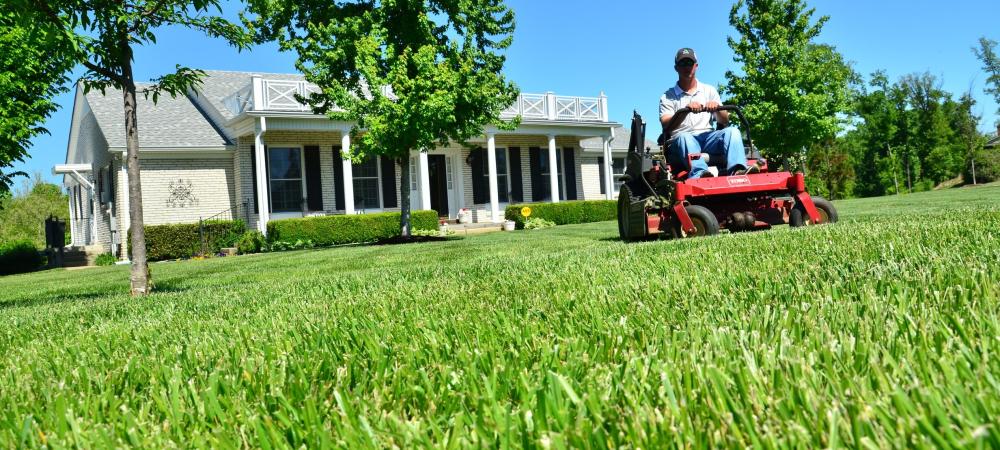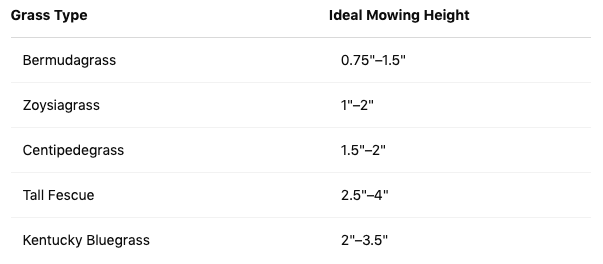Mowing Best Practices for North Carolina Grass Types

A healthy lawn starts with the right mowing practices. In North Carolina, where both warm- and cool-season grasses thrive depending on the region, proper mowing is essential for promoting growth, reducing weeds, and maintaining turf health year-round. This guide will walk you through mowing best practices tailored to NC’s common grass types and seasonal shifts.
Why Mowing Matters
Mowing is more than just a cosmetic chore—it directly affects your lawn's vigor and resistance to pests, disease, and drought. Mowing too short or infrequently can stress grass, weaken root systems, and leave lawns vulnerable to weeds and environmental stress. Regular, mindful mowing helps maintain a dense canopy, which shades out weed seeds and promotes healthy root systems capable of withstanding NC’s seasonal temperature swings.
Ideal Mowing Heights by Grass Type
Warm-Season Grasses
These grasses thrive in NC’s Piedmont and Coastal Plain regions:
- Bermudagrass: 0.75"–1.5"
- Zoysiagrass: 1"–2"
- Centipedegrass: 1.5"–2"
Warm-season grasses grow most actively in late spring and summer. Keeping them at the lower end of their recommended height encourages lateral spreading, which fills in bare spots and increases turf density. During periods of drought or high heat, a slightly higher cut helps preserve soil moisture and reduce stress.
Cool-Season Grasses
More common in the NC Mountains and shaded areas:
- Tall Fescue: 2.5"–4"
- Kentucky Bluegrass: 2"–3.5"
Cool-season grasses benefit from taller mowing, which increases root depth and helps the turf stay greener longer during summer heat. Taller blades also reduce evaporation and shade weed seeds, preventing them from germinating.
Quick-Reference Mowing Height Chart

Seasonal Mowing Guidelines
Summer Stress Adjustments
Raise mowing height slightly during hot, dry periods to shade the soil and reduce moisture loss. Mowing during early morning or late evening helps avoid additional heat stress. Keep blades sharp to ensure clean cuts, which heal faster and reduce the risk of fungal disease.
Fall and Spring Transitions
During active growth in spring and fall, mow more frequently to prevent overgrowth and scalping. Spring is also a great time to dethatch and aerate, setting up the lawn for optimal summer performance. In fall, continue mowing until grass stops growing, gradually lowering the blade height to prepare the lawn for dormancy.
Winter Considerations
In most NC regions, grass growth slows or stops in winter. Mow only when necessary to tidy the lawn and prevent matting. Avoid mowing when grass is wet or frost-covered, as it can cause tearing and long-term damage.
Equipment Essentials
Blade Sharpness
Dull mower blades tear grass blades, causing jagged edges that brown quickly and invite disease. Sharpen blades every 20–25 mowing hours or at the beginning of each season. A sharp blade ensures a cleaner cut, giving your lawn a polished appearance and healthier turf.
Basic Mower Maintenance Tips
- Clean the mower deck after each use to prevent grass buildup and rust.
- Check and change oil according to the manufacturer’s instructions.
- Replace air filters annually or as needed.
- Inspect spark plugs, tires, and belts to ensure safe and efficient operation.
- Keep mower blades balanced to avoid uneven cutting.
Proper maintenance not only extends the life of your mower but also improves cut quality and lawn health.
Professional Techniques
The One-Third Rule
Never remove more than one-third of the grass blade at a time. Cutting too much at once can shock the plant, weaken roots, and make your lawn more susceptible to stress. If your lawn is overgrown, reduce height gradually over multiple mowings.
Change Mowing Direction
Vary your mowing pattern with each session. Alternating direction encourages upright growth, prevents grass from leaning, and minimizes compaction from repeated wheel tracks. It also contributes to a more even lawn appearance.
Managing Problem Areas
For areas with uneven terrain, shade, or compacted soil, adjust your mowing habits. Use lighter equipment or trimmers near trees and slopes. Thin or bare patches may benefit from reseeding or topdressing. Combine mowing adjustments with soil improvement for better recovery.
Mowing with Confidence in North Carolina
Mastering your mowing routine is one of the simplest yet most impactful ways to improve lawn health in North Carolina’s diverse climates. From understanding the ideal heights for your specific grass type to adjusting your schedule with the seasons, consistent and mindful mowing promotes deeper roots, fewer weeds, and a greener, more resilient lawn. Combine these best practices with proper maintenance and observation, and your lawn will reward you with lush, healthy growth all year long.
